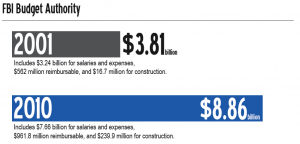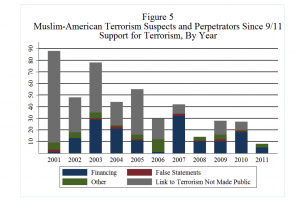When the Waffle House Plot broke last week, I joked that maybe the FBI will start profiling Waffle Houses rather than mosques; they’d probably have more luck finding terrorists there.
But I wanted to make a few points about the plot in addition to what Jim already said.
First, there are actually two sub-plots: one attempt to acquire silencers and explosives to attack federal buildings and employees; just Frederick Thomas and Dan Roberts are implicated in that plot. The other was a half-baked discussion to manufacture ricin. Ray Adams and Samuel Crump are primarily implicated in that plot, with Roberts and Thomas goading them on. That’s significant because while the weapons plot advanced steadily over time culminating in a purchase, the ricin “plot” consisted of some bragging in March, and some taped conversations in September and October, showing not only that the alleged attackers were largely ignorant about ricin, but also appearing to show them coaching the confidential informant in the case how to make ricin, not necessarily making it themselves.
If you’re gonna do this (unintelligible), it’s gotta be built, a hood. There can be no air, can’t be no disturbance.
[snip]
I can get ya seed (castor beans). I know where the seeds is at right now.
[snip]
You take a pound of that (unintelligible), get upwind, up around Washington, DC, get about 20,000 feet (in an airplane), and turn that shit loose, it’d cover the whole (unintelligible) of Washington.
That’s particularly significant because the last two conversations laying out the ricin plot–separate conversations October 29 with both Crump and Adams–were not recorded by the informant. And that informant? He’s a liar.
CHS1 is currently on bond for pending felony state charges. The FBI administered a polygraph test to CHS1 during the investigation of a militia group. The FBI polygrapher determined that CHS1 gave less than truthful responses concerning the activities of the militia group.
In short, the whole ricin plot seems like a bad advertisement for Red Devil lye, since Crump appeared to put off making the ricin because he couldn’t find that brand of lye; Adams, for his part, claimed he’d make lye himself by leaching wood ashes.
Given the lack of seriousness of the ricin plot, it appears to have been incited at the end in time for the bust in the other plot, to use guns and explosives to kill federal workers. That plot started back in March, included a surveillance trip in May, and discussions with an undercover FBI employee about buying weapons on June and July. On September 20, Thomas agreed to trade weapons 30 days later and also to pay $1000 for explosives. In late October, Thomas, Roberts, and the informant put together money to make the purchase. On November 1, Thomas and Roberts bought a silencer and what they believed to be explosives from an undercover FBI agent.
There’s just one weird thing about the evidence presented in the Thomas and Roberts affidavits. They describe planning for the final meeting–at which they’d pool their money to buy the silencers and explosives–to be held on October 29. The affidavits were signed on November 1. The indictment describes them buying a silencer and what they believed were explosives on November 1. But there’s no discussion about what happened at the October 29 meeting. Particularly given that the two ricin conversations on October 29 were not taped, I wonder whether the informant in this case got cold feet?
In any case, that’s what passes for a terrorist plot propagated by a bunch of senior citizen wingnuts.
Now, the plot is interesting for the way US Attorney Sally Quillian Yates used this FBI-abetted sting to warn about the risks posed by [senior] “citizens within our own borders who threaten our safety and security.”
While many are focused on the threat posed by international violent extremists, this case demonstrates that we must also remain vigilant in protecting our country from citizens within our own borders who threaten our safety and security.
I’m grateful that the FBI is finally focusing on domestic terrorists, even if they’re fluffing up the risk just as they do with aspirational Muslim terrorists. But note that, in spite of the involvement of the Joint Terrorism Task Force, it seems Yates can’t force herself to call these dudes terrorists. Perhaps they should rename the JTTF the JCWOOBWTOSASTF?
And of course there’s another difference between this and the crimes those brown people called terrorists commit. As Manssor Arbabsiar was alleged to have done, these militia members allegedly discussed assassinations. As Arbabsiar was alleged to have done, these plotters allegedly discussed explosives. Whereas with Arbabsiar, there is zero public evidence he affirmatively sought to use explosives to commit assassination, there is here. Unlike Arbabsiar, these militia members actually bought what they believed to be explosives.
And yet, unlike Arbabsiar, these alleged terrorists did not get charged with a WMD charge–not even for their alleged attempt to make ricin. Once again, it seems almost impossible for white terrorists to be charged with the FBI’s favorite charge for brown terrorists.
Finally, one more difference between the treatment of these scary white terrorists and scary brown ones. As TP’s Lee Fang notes (piggybacking off this GAPolitico post), Thomas was a commenter at RedState, where Erick Erickson has called for violence in the past.
Thomas blogged on RedState.com, the website edited by CNN’s Erick Erickson. The Thomas blog post highlighted by Baker and AJC revealed that at one point, he did not “advocate a general rebellion against the U.S. Government for cause,” but seemed conflicted about the idea of violent revolution. Something apparently changed between that unpromoted post, published in July of 2008 and this year, when the alleged plot began taking shape.
A ThinkProgress examination of Thomas’s online writing in the following years shows that the alleged terrorist grew more and more upset, and expressed sympathy with the anti-Obama conspiracies posted on RedState. Last year, he posted a comment to a popular RedState post about the evils of health reform. Thomas claimed that the “ObummerCare Bill” not only “won’t be forgiven,” but will lead to “TYRANNY of the worst order” and “civil war.” (view a screenshot of the comment here)
And as the affidavits make clear, the plot was inspired by a Mike Vanderboegh novel; Fang notes that Thomas has also commented on Vanderboegh’s blog. Last year, Vanderboegh claimed credit for coordinated attacks in protest of the health insurance reform–one of them targeted at Gabby Giffords–in three states.
On Friday, former militia leader Mike Vanderboegh called for anti-Democratic vandalism across the country to protest the health care bill.
Vanderboegh posted the call for action Friday on his blog, “Sipsey Street Irregulars.” Referring to the health care reform bill as “Nancy Pelosi’s Intolerable Act,” he told followers to send a message to Democrats.
“We can break their windows,” he said. “Break them NOW. And if we do a proper job, if we break the windows of hundreds, thousands, of Democrat party headquarters across this country, we might just wake up enough of them to make defending ourselves at the muzzle of a rifle unnecessary.”
And, apparently in response, there were attacks in–at least–Wichita, KS, Tucson, AZ, Rochester, NY, Niagara Falls, NY. Vanderboegh has proudly claimed credit for the coordinated attacks.
Now maybe Vanderboegh and Erickson are just the FBI’s latest incarnation of Hal Turner, wingnut bloggers they pay to inspire other wingnuts whom they can arrest in Waffle House plots; maybe the FBI hasn’t tracked their calls for violence at all. But if Vanderboegh and Erickson were Muslim propagandists advocating violence–like Anwar al-Awlaki or Samir Khan–they’d probably be worried about a drone raining down from the sky. I’m definitely not advocating that for any propagandists, whether Muslim or wingnut, being killed for their protected, albeit vile, speech.
But maybe now that the government is using stings to warn of the danger of domestic terrorists, those inciting them ought to think more seriously about how our government combats terrorists.



